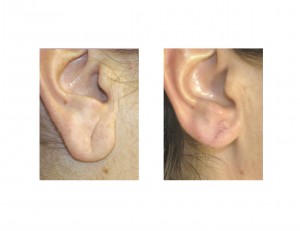Background: One of the important components of an ear that contributes significantly to its appearance is the size and shape of the earlobe. Earlobes are as variable and unique to each individual as fingerprints. The earlobe is composed only of skin and fat without any cartilage support. As a result of no internal cartilage framework, the earlobe is subject to change from age, gravity, surgery, and ear ring wear. This change is always one of elongation, making the ear less attractive due to the change in ear proportions. Rarely, even a young person may have naturally long or large earlobes.
Case Study: This is a case of a 32 year-old female who was unhappy with her large earlobes. She had been self-conscious about them since she was young. She always covered her ears by wearing her hair long over them, never pulling her hair back. She said her earlobes had always been big since she was born. She did not wear ear rings so attention was not brought to them.

While an earlobe reduction is a simple operation, there are a few technical points. At the helical rim, a small v or notch should be placed in a female (anterior) and male (posterior) pattern. This allows the scar as it crosses the rim to not be a straight line. This will prevent the potential for a visible notch to develop as scar contracture occurs with healing. Closure of the wedge resection is done in three layers with resorbable sutures on the back and in the middle and fine removeable sutures on the visible anterior surface.
After closure, flesh-colored tapes are glued on the ears in a wraparound fashion. She could shower and wash her hair the next day without any restrictions. The outer surface earlobe sutures are removed a week later. One can pierce their ears and wear ear rings six weeks after surgery.
With her earlobe reduction, she now wears her hair back for the first time.
Case Highlights:
1) Earlobe reduction is a simple office-based plastic surgery operation. It can be done alone or in combination with any other type of plastic surgery.
2) While earlobe reduction does leave a scar, it is imperceptible and should not leave a visible notch on the helical rim.
3) The earlobe can not only be reduced but the shape can be also changed to a wider or more narrow configuration as the patient chooses.
Dr. Barry Eppley
Indianapolis, Indiana


